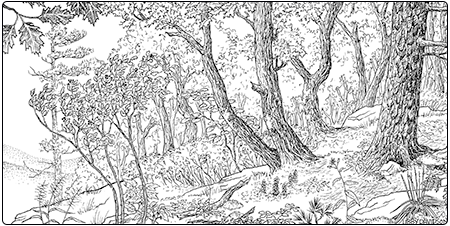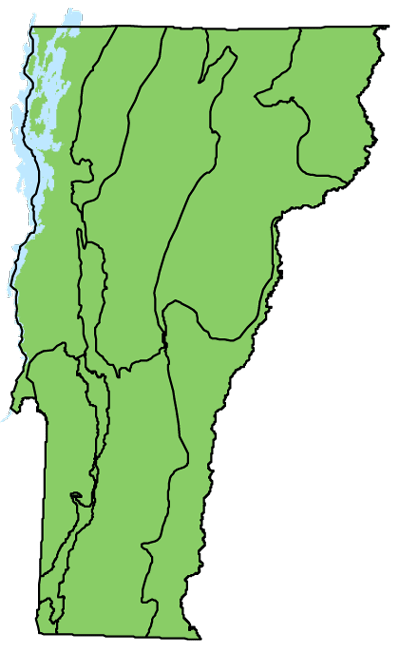Ecology and Physical Setting
These beautiful, airy forests occur on warm slopes and rocky hills in the moderate climate areas of the state. Dry Red Oak-White Pine Forests are best developed on south- and southwest-facing slopes, which can be gradual or steep. Soils are shallow, and bedrock is typically acidic, although the community can occur on calcareous bedrock. The combination of slope, aspect, and shallow soils make these sites warm and dry, and create a setting that favors red oak and other drought-tolerant species.
Outside of the Champlain Valley, Dry Red Oak-White Pine Forest is the most northern of Vermont’s oak-dominated forests. Farther south, in the warmest parts of Vermont, similar physical settings support Dry Oak Forest and related communities with several species of oaks, hickories, and other more southern trees.
An interesting distribution pattern of Dry Red Oak-White Pine Forests is that they occur on south-facing slopes of several river valleys, including the White, West, Winooski, and Black Rivers. These slopes are relatively warm and extend the distribution of Dry Red Oak-White Pine Forest into the Northern and Southern Green Mountains.
Although fire may play a role at some sites, it appears that the warm, dry conditions are responsible for perpetuating the community. Periods of summer drought are a source of stress and tree mortality, and drought may play a greater role with climate change. The sunny and warm soils are good germination sites for both red oak and white pine, and scattered seedlings respond well to canopy gaps. In contrast, the seeds of sugar maple need moist, cool soil to germinate, and seedlings need shade to survive. The conditions on these ridgelines and slopes are likely responsible for the absence of sugar maple, the most abundant tree species in Vermont.
Vegetation
Red oak dominates these forests. Southern species such as chestnut oak and white oak are absent. The canopy is generally closed, but the warmest and driest sites support woodlands with sparse, stunted trees. Red oak never reaches its maximum potential height in this water- and heat-stressed community. White pine may be co-dominant, a sparse associate, or absent at some sites. When present, tall white pine trees commonly emerge above the red oak canopy and their branches are flagged to one side as a result of persistent wind. Hophornbeam may be present on sites with calcium-rich bedrock.
Stout trunks and overarching red oak branches create an open forest interior. Low sweet blueberry is abundant, and black huckleberry is also common. Other characteristic shrubs include maple-leaved viburnum, striped maple, witch hazel, and wintergreen. The herbaceous layer is sparse. Characteristic species include bracken fern, blue-stemmed goldenrod, panicled hawkweed, rough leaf rice-grass, and cow-wheat.
Wildlife Habitat
Red oak acorns provide food for many species of wildlife, especially black bears, turkeys, deer, gray squirrels, and blue jays. Acorn mast is especially important in Dry Red Oak-White Pine Forests as this community represents some of the most northern populations of red oak in Vermont. Red squirrels are also common in these forests, where the seeds of white pine are an important part of their diet. Breeding birds include those associated with forest interiors, like black-throated blue warbler, scarlet tanager, and ovenbird, as well as those associated with a more open forest canopy, like Nashville warbler. Blackburnian warblers and black-throated green warblers are attracted to the mixed forest. Pine warblers are attracted to the tall white pines. The uncommon saw-whet owl nests in open pine woods. These small owls commonly use abandoned pileated woodpecker holes for nests. The Carolina andrena bee relies on the pollen of heath family shrubs, which are abundant in Dry Red Oak-White Pine Forests.
Successional Trends
Forests of red oak and white pine are common in early-successional and old field settings and these typically succeed to other community types as they mature. But Dry Red Oak-White Pine Forests appear to persist long-term on warm, droughty sites.
Variants
- Dry Red Oak-White Pine Woodland is the driest expression of a Dry Red Oak-White Pine Forest and has a stunted canopy with less than 60 percent cover. While small woodland inclusions are a normal part of Dry Red Oak-White Pine Forest, this variant describes more extensive woodlands. It lacks chestnut oak and white oak.
Related Communities
- Dry Oak Forest occurs in similar physical settings, but it is restricted to the warmest regions of Vermont. White oak, chestnut oak, and/or black oak are present in the canopy.
- Dry Chestnut Oak Woodland is similar to the woodland variant of this community, but it is distinguished by the warmer setting and abundance of chestnut oak and/or white oak.
- Dry Oak-Hickory-Hophornbeam Forest typically occurs on calcareous bedrock, with a canopy dominated by red oak, shagbark hickory, and hophornbeam. White oak and white ash are often present. Woodland sedge typically forms a lawn, and there is a diversity of herbaceous plants that includes many calcium-loving plants.
- Red Oak-Northern Hardwood Forest is dominated by northern hardwood species (primarily sugar maple and beech) with a strong component of red oak. Soils are deeper and moister.
Conservation Status and Management Considerations
This uncommon natural community occurs on steep slopes and has stunted trees with little commercial value, so many sites are in excellent condition. There are several high-quality examples of Dry Red Oak-White Pine Forest on conserved lands. If harvesting is pursued in these forests, care should be taken to maintain red oak and white pine in the canopy. Development of ridgetop communication towers can be a threat. Although invasive species are typically not a threat in this dry, mostly acidic community, canopy removal and soil disturbance from logging will increase the risk. Monitoring and control measures should be part of forest management.
Distribution/Abundance
Dry Red Oak-White Pine Forests are uncommon, but likely occur in all biophysical regions. They occur on warm, south-facing slopes at elevations from 500 to 2,200 feet. Similar communities are known from across northern New England.
Characteristic Plants
Trees
Abundant Species
Red oak – Quercus rubra
White pine – Pinus strobus
Occasional to Locally Abundant Species
American beech – Fagus grandifolia
Hophornbeam – Ostrya virginiana
Red maple – Acer rubrum
Shrubs
Abundant Species
Low sweet blueberry – Vaccinium angustifolium
Black huckleberry – Gaylussacia baccata
Occasional to Locally Abundant Species
Maple-leaved viburnum – Viburnum acerifolium
Late low blueberry – Vaccinium pallidum
Striped maple – Acer pensylvanicum
Common shadbush – Amelanchier arborea
Witch hazel – Hamamelis virginiana
Partridgeberry – Mitchella repens
Herbs
Occasional to Locally Abundant Species
Bracken fern – Pteridium aquilinum
Blue-stemmed goldenrod – Solidago caesia
Panicled hawkweed – Hieracium paniculatum
Wintergreen – Gaultheria procumbens
Rough leaf rice-grass – Oryzopsis asperifolia
Marginal wood fern – Dryopteris marginalis
Trailing arbutus – Epigaea repens
Cow-wheat – Melampyrum lineare
Woodland sedge – Carex pensylvanica
Canada mayflower – Maianthemum canadense
Silverrod – Solidago bicolor
Large-leaved aster – Eurybia macrophylla
Wild oats – Uvularia sessilifolia
Sarsaparilla – Aralia nudicaulis
Pink lady’s slipper – Cypripedium acaule
Bryophytes
Pincushion moss – Leucobryum glaucum
Rare and Uncommon Plants
Squawroot – Conopholis americana
Silver-flowered sedge – Carex argyrantha
Associated Animals
Black bear – Ursus americanus
Eastern gray squirrel – Sciurus carolinensis
Red squirrel – Tamiasciurus hudsonicus
Blackburnian warbler – Setophaga fusca
Eastern wood pewee – Contopus virens
Red-eyed vireo – Vireo olivaceus
Wood thrush – Hylocichla mustelina
Black-throated green warbler – Setophaga virens
Scarlet tanager – Piranga olivacea
Ovenbird – Seiurus aurocapilla
Pine warbler – Dendroica pinus
Nashville warbler – Oreothlypis ruficapilla
Hairy woodpecker – Picoides villosus
Rose-breasted grosbeak – Pheucticus ludovicianus
Tufted titmouse – Baeolophus bicolor
Eastern towhee – Pipilo erythrophthalmus
Carolina andrena bee – Andrena carolina
Rare and Uncommon Animals
Northern saw-whet owl – Aegolius acadicus
Places to Visit
Snake Mountain Wildlife Management Area, Addison, Vermont Fish and Wildlife Department (VFWD)
Mount Moosalamoo, Salisbury, Green Mountain National Forest
White River Wildlife Management Area, Sharon, VFWD
Jamaica State Park, Jamaica, Vermont Department of Forests, Parks, and Recreation
Black Mountain, Dummerston, The Nature Conservancy
